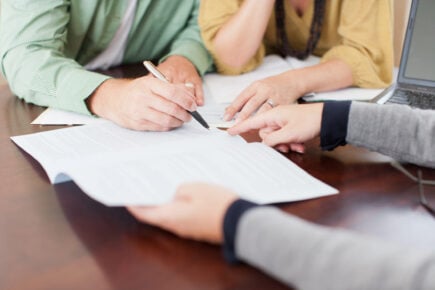In Australia, there are a number of prerequisites you need to satisfy before a lender will deem you suitable for a home loan. But before that happens, there are a series of decisions you need to make and an overarching home loan application process to understand. Here’s where to get started.
The home loan application process
The home loan application process generally follows these steps before the house-hunting begins:
- Understand the eligibility requirements.
- Get your finances in order.
- Identify the right home loan for you.
- Explore pre-approval options.
1. Understand the eligibility requirements
Eligibility requirements may differ slightly from lender to lender, but they all require the same key information before proceeding. The first thing a lender will require is your personal details including:
- name.
- address.
- evidence of citizenship or permanent residency.
- age.
Most lenders require borrowers to be at least 18, although unless you’re an IT prodigy or a pop star, it’s highly unlikely you’d be in the market for a home before then anyway. Age may be a factor in the length of the loan you are seeking, and if you’re older, say in your late 40s or 50s, you may be required to take out a shorter term for your mortgage, meaning higher fortnightly or monthly repayments.
2. Get your finances in order
Next, you will need to provide detailed information about your financial situation to determine your ability to repay the loan over the agreed-upon term of the mortgage. If you are single and applying for a loan in your name only, the process will be far more straightforward than if you want a joint loan. The lender will also want to know if you have any dependants and your financial commitments, if any, to them.
The chief factors the lender will assess are:
- Income and expenses.
- Employment.
- Assets and liabilities (debts).
Income and expenses
Your income is important because it will determine how much money you regularly have coming into your account and how much you can therefore afford to borrow. Most of your income likely will be derived from your full-time job, but your income also could include other types of regular payments, such as freelance or casual work, or a side business selling content on eBay, for instance. The lender will want to see your bank account history to gauge how regular your income is and your ability to repay the mortgage after deducting your monthly expenses, such as groceries, petrol, entertainment, internet, mobile phone and debts, such as a car loan or credit cards, if you have any. If you’ve been renting for a while a lender may also want to see your rental history to establish a pattern of regular payments.
Employment
To establish a pattern of stability, a lender will then want to check your employment history, which usually entails providing payslips and a record of employment from your employer. This step will be more straightforward if you’ve worked in the same full-time role for a number of years as opposed to regularly hopping from one job to another. If you are self-employed as a freelancer or contractor, your application will be more complicated as you’ll need to provide proof of regular income through bank statements, tax returns and possibly a letter from an accountant.
Assets and liabilities
Finally, your lender will want to see your assets and liabilities. Your assets are basically anything of value that you own, such as money in bank accounts including term deposits and other types of savings accounts, cars or other vehicles, shares, or even stamp and coin collections. Each lender’s definition of assets will differ so it may be in your interest to talk to your lender if you’re unclear about what to include in your loan application.
Liabilities will include any existing loans and credit card debts. Importantly, when it comes to credit cards, the lender will always look at the limit, so if your current card has a limit of $15,000, that’s what the bank will take into account, even if you only owe $500 on it, so paying off your credit cards and getting rid of them will greatly help to reduce your liabilities.
3. Identify the right home loan for you
Your financial situation and goals will help you determine which home loan is right for you. You also will need to understand things like the difference between a mortgage and a home loan (a home loan is the money borrowed to buy property, and the mortgage is the loan agreement between the lender and the buyer).
While owner-occupier is one of the more common types of mortgages, it’s good to understand all your options, including reverse mortgages, lines of credit and construction loans. You also will want to make sure you understand how home loan interest rates work, as well as the difference between fixed-rate and variable loans.
4. Explore pre-approval options
Home loan pre-approval is when a lender agrees to lend you a certain amount of money to purchase a property. Pre-approval gives you, the borrower, the freedom and confidence to put in an offer up to the agreed-upon pre-approved amount. Without this step, you won’t really know how much you can borrow.
Before gaining pre-approval, the bank will factor all of the above into account, as well as your credit score, which includes detailed information about your credit history and your debt-to-income ratio (how much money you make compared with how much you owe), to determine whether you qualify for a loan.
Before giving final or unconditional approval for a home loan, the lender will determine the value of your desired property based on a range of factors including its size, age, condition, and location, to arrive at a loan-to-value ratio (LVR). If, for example, you wish to buy a property on the market for $500,000, and the bank values it at only $400,000, the lender may decide not to offer you a loan because they will struggle to recoup the value of the loan if, in a worst-case scenario, they are forced in the future to sell the property to recover their loan.
The amount you have saved as a deposit, an amount of the total cost of the property which is payable upfront, will also determine how much you need to borrow to buy the property. If your deposit is less than 20% of the total cost of the property you may have to pay lenders mortgage insurance (LMI).

How Do Home Loan Interest Rates Work?
Home loan interest rates are determined by credit score, loan-to-value ratio, inflation and more.

Glossary of Home Loan Terminology
Confused by mortgage terminology? This home loan glossary includes words and phrases first-time buyers are likely to encounter in Australia.

How Much Do You Need for a House Deposit on a Home Loan?
A house deposit, or a home loan deposit, is your initial contribution to the total purchase price of a property — typically 5%-20%.

How Much Can I Borrow for a Home Loan?
Start by figuring out what amount your bank will lend you and, more importantly, what you can afford to borrow.

